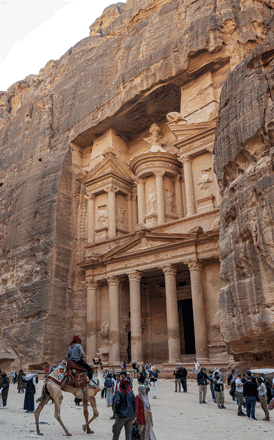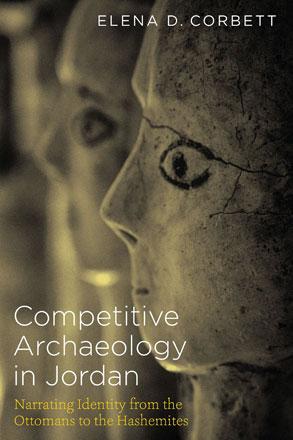You are here
The Nabataeans: ‘The most unjustly forgotten’
By Sally Bland - Jun 26,2016 - Last updated at Jun 26,2016

Petra and the Lost Kingdom of the Nabataeans
Jane Taylor
London-New York, I. B. Tauris; Amman: Al ‘Uzza Books, 2012
Pp. 224
Jane Taylor has many accomplishments, but in Jordan especially, her name is inextricably linked to Petra, because of her unsurpassed photographs of the site. Her latest book, “Petra and the Lost Kingdom of the Nabataeans”, contains many of her photos, but also shows that she was not content to simply record spectacular monuments in their beautiful natural environment. Over time, the ruins obviously “spoke” to her, arousing her curiosity and admiration for their creators. While this book is based on archaeology, it goes beyond the monuments to investigate the less-apparent human element — the Nabataean people and society. Taylor’s motivation is clearly stated in the preface to the book: “Of all the powerful, rich and gifted people of the ancient world, the Nabataeans are the most unjustly forgotten.” (p. 8)
Modestly, Taylor does not claim original scholarship, but “tried to assimilate something of the fascinating work of those who have been at the sharp end of archaeological and historical research”. (p. 8)
The great value of the book is that it makes accessible to a broad readership information that is usually only found in specialised academic and archaeological literature. Yet, Taylor does more than sum up previous knowledge: She adds a strong social history slant, and her lively, human-oriented and sometimes playful prose proves that ancient history isn’t stiff or boring.
In a sense, the book is an extended argument for why it is unfair that the Nabataeans have been so overlooked. Taylor develops this argument by chronicling their origins, the challenges they faced from the environment and other groups and empires, their linguistic, hydraulic and architectural achievements, and how they organised their society. Documenting all this was no easy task due to the paucity of written records.
The book begins with information about frankincense and myrrh, and their usage in the ancient world, as it was trade in incense that turned the Nabataeans from nomads of the Arabian Peninsula, into cosmopolitans with an infrastructure that stretched to the Sinai and southern Syria, and trade routes extending to Rome and India. It is fascinating to learn that originally they banned cultivation and home building on pain of death! However, early on, they developed expertise in water conservation, digging well-disguised underground cisterns throughout the territory they traversed. Besides ensuring survival, they “found that their control of water facilitated freedom of movement”, and freedom was something they treasured highly. (p. 17)
Being constantly on the move brought the Nabataeans into contact with other ancient civilisations from whom they learned. Their hydraulic skills most likely derive from the Sabaeans who built the Marib Dam in today’s Yemen, just as they were later to assimilate elements of Assyrian, Greek, Roman and other cultures. According to Taylor: “Their gift was to learn from the skills of others, and to transform disparate ideas into something uniquely their own.” (p. 17)
Over time, the need to protect their lucrative caravan routes superseded the building ban, and fortresses and caravanserais were erected in strategic locations as they moved westwards and northwards, eventually concentrating on the Petra area, and making it their capital. As the settled population grew so did their agricultural endeavours.
Large sections of the book read like a history of the whole area, charting the Nabataeans’ encounters with other civilisations of the time in Arabia, Edom, southern Palestine, Egypt and Syria, plus the Romans and Greeks. The Nabataeans seemed to have preferred diplomacy to avoid conflict, but there were also plenty of battles and intrigues. While here in Jordan we tend to think of them exclusively in terms of Petra, much of the archaeological evidence about their civilisation comes from other corners of their empire.
Throughout, Taylor compares archaeological evidence with the writings of ancient historians and the Bible. She often presents alternative interpretations, clearly identifying what is documented fact as opposed to theories or suppositions, and encouraging the reader to think.
The most fascinating parts of the book cover the Nabataeans’ adaptable culture, language and social organisation. They spoke a dialect of Arabic but wrote in Aramaic. In contrast to some other empires, they seemed to have ruled more by consent than cruelty. An effective administration in Petra kept the peace among residents, and accorded women clear property rights. There seem to have been few slaves, so the amazing architectural feats were done by citizens with simple tools. They were syncretic in religion, adopting the gods of neighbouring peoples alongside their own. There are signs that Nabataean kings were close to their subjects and held accountable to a popular assembly — all in all, attributes of good governance that have yet to be realised universally in our world today.
The book includes excellent maps of the city of Petra, Nabataean trade links in the ancient world, and the Nabataean Kingdom at its height. It is available at ACOR (American Centre of Oriental Research).
Related Articles
PETRA — “Here, this is the gateway to the monastery, the most beautiful and famous monument of Petra,” said Abraham Mashaleh, 48, a Jordania
AMMAN — Despite the harsh desert climate, the Nabataean inhabitants of ancient Petra were capable of growing different kinds of agricultural
Competitive Archaeology in Jordan: Narrating Identity from the Ottomans to the HashemitesElena D.



















